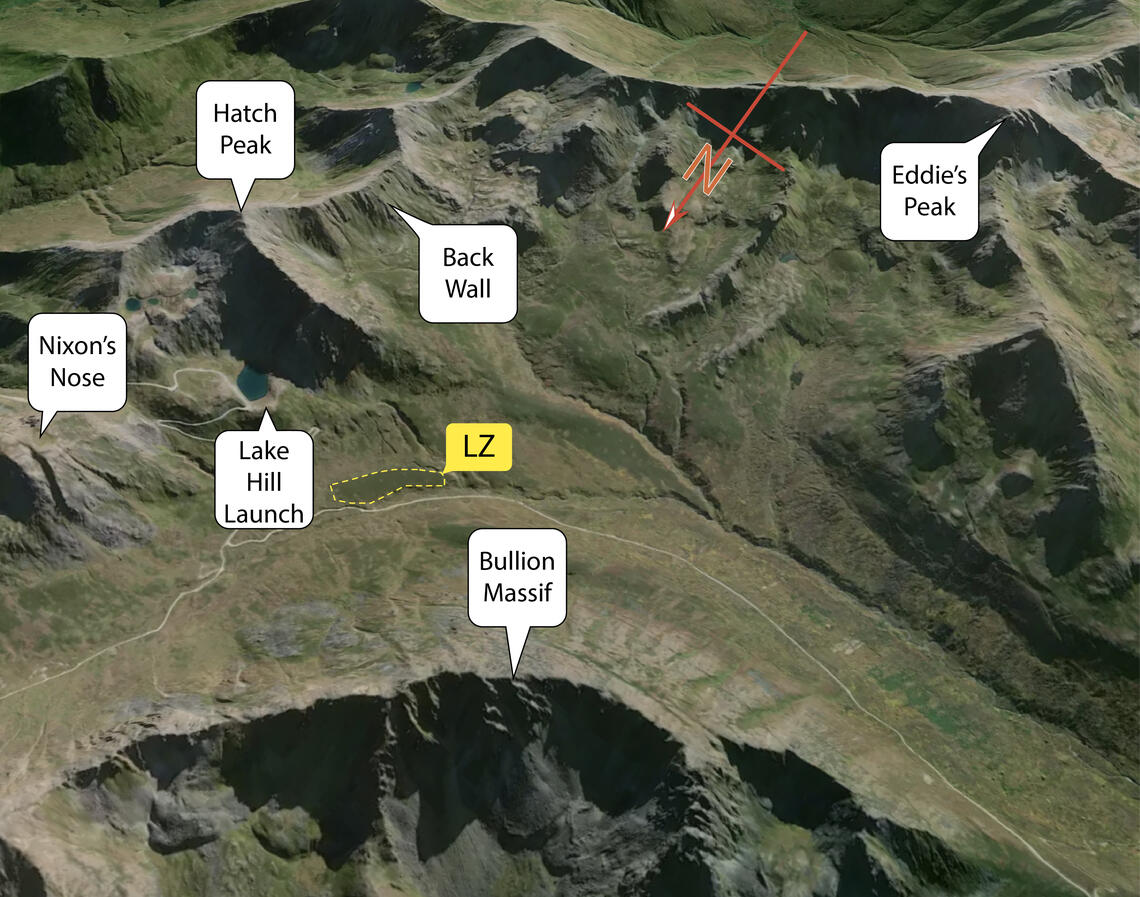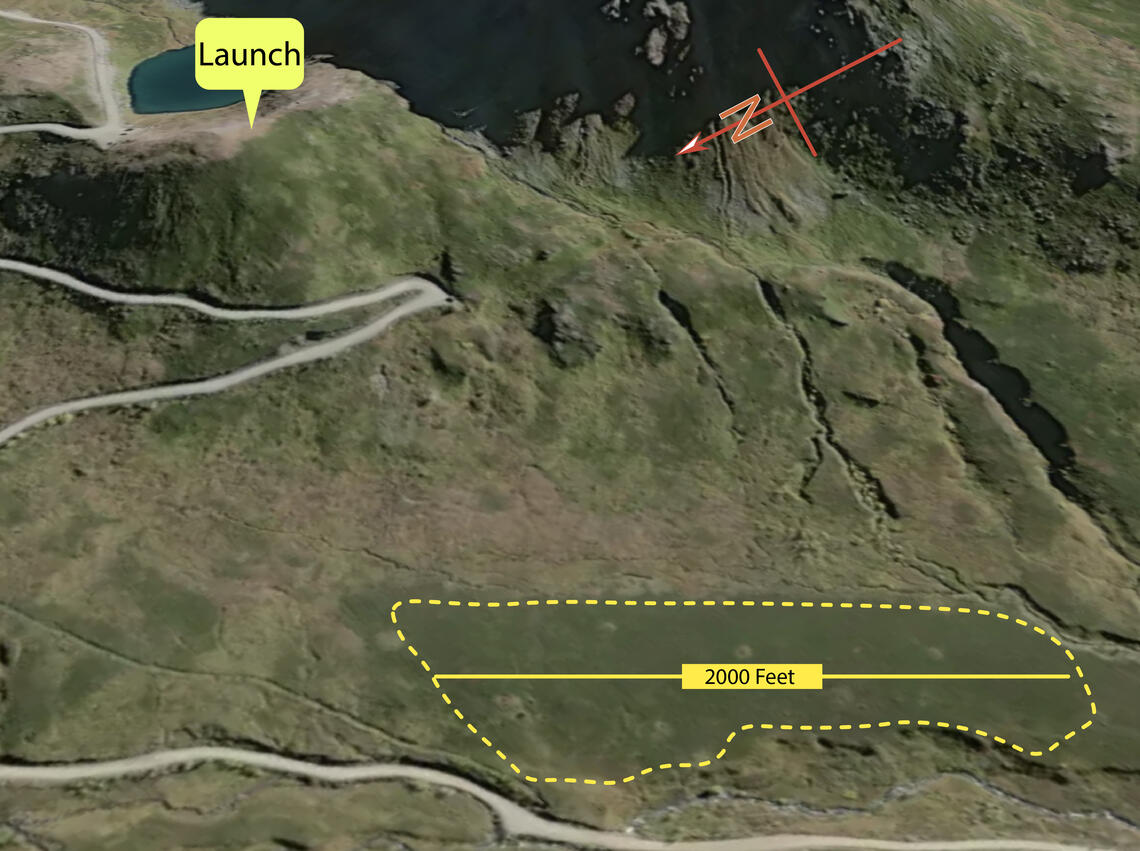Description
|
Pilot Recommendations
Bench Launch: P2/H3 P3 skills recommended for XC flights
In person site intro recommended, especially for pilots flying XC |
Weather Conditions Wind Direction: 280° ideal w/ 10° variance PG: Min:0mph/Ideal:10mph/Max:15mph/Gust:3mph HG: Min:5mph/Ideal:15mph/Max:20mph/Gust:5mph Glide Ratio to L/Z: 3.8
|
Hazards Overdevelopment is a major hazard while flying in Hatcher Pass. Cumulonimbus clouds extending above 30k feet are not uncommon Avoid flying too close to the exit stream of Summit Lake, as this can be a venturi area When landing in tundra, beware of hummocks and marmot/ground squirrel holes that can easily cause ankle injuries This is an exceedingly popular tourist destination. Make sure that spectators are given proper space. |
|
Restrictions Do not land within 50' of other recreatorsDo not land on the road or in the parking lot. |
||
This site is not managed or maintained by the Arctic Air Walkers, and this Site Guide is provided to assist pilots in making good decisions about flying at this site.
Lake Hill is one of the most popular launch sites in Alaska. It's the only site where you can drive within a hundred yards from launch and offers both thermal and ridge soaring opportunities. The spacious LZ, soft ground, steady winds, and nice launch makes it a great place to train new pilots, and get reacquainted after the long dark winters. This site is located on the west side of Hatcher Pass along West Willow Fishhook Road. The launch is situated on a knoll to the west of Summit Lake and overlooks Willow Creek Valley. The landing zone is directly west of launch and is the extremely large open meadow at the base of the valley. This is a popular overlook for hikers and folks driving through the pass so parking can be limited. It's common for pilots to double park to optimize parking space but be sure not to block in non-pilots. A site intro is recommended before flying this site. This is a very popular tourist destination, and there will be spectators for your launch. It is imperative to communicate with them to have the required space to launch, especially in strong conditions. Lake Hill is a mountain ridge and thermal site.
Launch

The launch at Lake Hill is one of the best in the state. There is ample space directly behind the launch ridge for pilots to layout and check gear. There is space for 3-4 wings to setup on the launch ridge. If conditions are strong, it is possible to walk down the hill to find easier condition. It is located a short walk along an obvious trail.
The launch area is a moderately sloping west facing hill. It is a great area for beginner pilots, with minimal hazards. The biggest hazard can be the bystanders/spectators. It is essential to communicate with them to ensure appropriate separation from launch activities.
The main restriction of this flying site is the limited initial ridge soaring space. The ridge can support 2 or 3 pilots, until they gain enough height to make the transition to "The Diving Board". This aptly named feature is the landmark that designates the point to hit to be able to link into the rest of the Lake Hill ridgeline. If too many pilots launch simultaneously, they can all get pushed out and be forced to land. If it is truly "on, pilots only need a couple passes to reach the required height, making a little patience go a long way.
To make the transition to the Diving Board, pilots only need to get ~100ft above launch. After making that move, the next landmark is to get above the weather station pole that sits on the ridgeline above. When you are above this point make the transition to the Back Wall, and the rest of the bowl is open to explore!

Landing Zones
Lake Hill Meadow
61.767642, -149.332523

The Lake Hill Meadow LZ is a vast open space at the base of Lake Hill and is an ideal place to land if you sink out after launching from Lake Hill. With approximately 1² mi. of area, this a fantastic beginner LZ. This is also the primary LZ for Nixon's Nose when launching to the west. The LZ slopes slightly downhill to the west into the prevailing wind. Be aware of the creek that forms a western boundry to the area.
The nearby road and heavy tourist traffic make a retrival from this LZ easy. It is also a relativly short hike to get back to launch.
Weather Considerations
- Pilots need to keep a careful watch on weather conditions, both on launch and in the air.
- Ideal winds are from 280° with a 10° variance either side.
- Ridge soaring still works well when the wind direction is up to 20 degrees north from straight in.
- Reccomended wind strengths are:
- PG: Min: 0mph / Ideal: 10mph / Max: 15mph / Gust 3mph
- HG: Min: 5mph / Ideal: 15mph / Max: 20mph / Gust 5mph
- Do not fly when there's a signficant southerly or northerly component. This can result in signficant mechanical turbulence.
- The typical approach to thermalling is to ridge soar out into the valley and catch thermals or fly to the western ridge of Hatch peak and transition to thermal flying there.
- Be cautious about soaring when the cloud deck is low over launch to avoid soaring into the cloud.
Requirements
Pilots are expected to evaluate the launch, the possible landing areas, the weather, and other conditions. Flights are at the Pilot's own risk.
P2/H3 is the recommended pilot level, with a P3 recommendation for pilots thinking to fly XC. Some instruction is done at this site under instructor supervision.
Modification or "grooming" of the trail and launch area is forbidden by the Park Service, and doing so could jeopardize further use of the area.
Hazards
- Massive overdevelopment is one of the biggest hazards at Hatcher Pass. It’s very common for towering cumulonimbus clouds to blast into the sky past 30,000 feet. These clouds will suck you up, chew on you for hours, and spit your frozen corpse out somewhere in the remote and inaccessible Talkeetna Mountains. Be aware that this development can occur quickly above you and it’s not always obvious that it’s happening until it’s too late. Blue sky over the Matanuska-Susitna Valley doesn’t mean that you’re safe. In fact it often means that you’re not. Scared? Good.
- There are a lot of converging, diverging, and mixing valley flows in the Hatcher Pass area. Stay alert.
- Winds can shift quickly. Be sure to check the full day weather forcast before flying.
- The Launch Ridge slopes back and down towards Summit Lake, and poses a rotor hazard behind the ridge. Normal top-landing protocol is to parallel the ridge as it drops off to the north, and to be flying directly into the prevailing wind, and then to angle across towards the launch area. Be aware of other pilots soaring the launch ridge and bystanders standing watching on toplanding LZ.
- The canyon with the stream coming out of Summit Lake to the south of launch can form a venturi. Stay in front of the main ridge, and do not soar back into the venturi zone over the creek.
- Other hikers/spectators visit this site and the potential for a conflict exists. Pilots are cautioned to ensure an appropriate distance is maintained between launch and landing activities and the public. Pilots are expected communicate to the public as needed to maintain clearances.
- This is a natural mountain site and there are many natural hazards that are common to many natural mountain sites in Alaska that could be a hazard for pilots.
- There may be no cell phone reception in many backcountry areas. Pilots are expected to be prepared for self-rescue and by carrying Spot, InReach or other non-cell based communication equipment.
- The entire landing zone is covered in large tussocks that present a tripping hazard to landing pilots. Fortunately the ground and the tussocks are generally soft.
- There are no permanently installed wind socks or wind tells. Pilots are expected to bring their own if they feel that they need one. Someone will almost always set one up on good days.
- In the event of an incident, emergency response is likely to take more than a hour to arrive.
WARNING: The descriptions of typical flying conditions listed in this Site Guide reflect the experience of the authors of the guide. The conditions that you encounter at the site may differ, sometimes substantially, from those described. These descriptions may not be relevant to the possible experience of any other pilot, particularly one who is relatively inexperienced or new to the Site.


